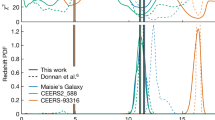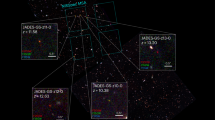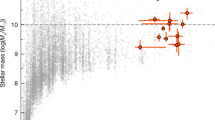Abstract
ONE of the most direct methods of constraining the epoch at which the first galaxies formed—and thereby to constrain the age of the Universe—is to identify and date the oldest galaxies at high redshift. But most distant galaxies have been identified on the basis of their abnormal brightness in some spectral region1–4; such selection criteria are biased towards objects with pronounced nuclear activity or young star-forming systems, in which the spectral signature of older stellar populations will be concealed. Here we report the discovery of a weak and extremely red radio galaxy (53W091) at z = 1.55, and present spectroscopic evidence that its red colour results from a population of old stars. Comparing our spectral data with models of the evolution of stellar populations, we estimate that we are observing this galaxy at least 3.5 Gyr after star-formation activity ceased. This implies an extremely high formation redshift (z > 4) for 53W091 and, by inference, other elliptical galaxies. Moreover, the age of 53W091 is greater than the predicted age of the Universe at z = 1.55, under the assumption of a standard Einstein–de Sitter cosmology (for any Hubble constant greater than 50kms−1 Mpc−1), indicating that this cosmological model can be formally excluded.
This is a preview of subscription content, access via your institution
Access options
Subscribe to this journal
Receive 51 print issues and online access
$199.00 per year
only $3.90 per issue
Buy this article
- Purchase on SpringerLink
- Instant access to full article PDF
Prices may be subject to local taxes which are calculated during checkout
Similar content being viewed by others
References
McCarthy, P. J. A. Rev. Astr. Astrophys. 31, 639–688 (1993).
Steidel, C. C., Pettini, M. & Hamilton, D. Astr. J. 110, 2519–2536 (1995).
Steidel, C. C., Giavalisco, M., Pettini, M., Dickinson, M. & Adelberger, K. L. Astrophys. J. 462, L17–L20 (1996).
Petitjean, P., Pécontal, E., Valls-Gabaud, D. & Charlot, S. Nature 380, 411–413 (1996).
Dunlop, J. S., Guiderdoni, B., Rocca-Volmerange, B., Peacock, J. A. & Longair, M. S. Mon. Not. R. astr. Soc. 240, 257–284 (1989).
di Serego Alighieri, S., Fosbury, R. A. E., Quinn, P. J. & Tadhunter, C. N. Nature 341, 307–309 (1989).
Tadhunter, C. N., Scarrott, S. M., Draper, P. & Rolph, C. Mon. Not. R. astr. Soc. 256, 53P–58P (1992).
Rigler, M. A., Lilly, S. J., Stockton, A., Hammer, F., Le Fèvre, O. Astrophys. J. 385, 61–82 (1991).
Hamilton, D. Astrophys. J. 297, 371–389 (1985).
Lilly, S. J. Astrophys. J. 333, 161–167 (1988).
Stockton, A., Kellogg, M. & Ridgway, S. Astrophys. J. 443, L69–L72 (1995).
Rawlings, S. & Saunders, R. Nature 349, 138–140 (1991).
Dunlop, J. S. & Peacock, J. A. Mon. Not. R. astr. Soc. 263, 936–966 (1993).
Windhorst, R. A., van Heerde, G. M. & Katgert, P. Astr. Astrophys. Suppl. Ser. 58, 1–37 (1984).
Oort, M. J. A. & van Langevelde, H. J. Astr. Astrophys. Suppl. Ser. 71, 25–38 (1987).
Oort, M. J. A., Katgert, P., Steeman, F. W. M. & Windhorst, R. A. Astr. Astrophys. 179, 41–59 (1987).
Neuschaefer, L. W. & Windhorst, R. A. Astrophys. J. Suppl. Ser. 96, 371–399 (1995).
Dunlop, J. S., Peacock, J. A. & Windhorst, R. A. in Galaxies in the Young Universe 84–87 (Springer, Berlin, 1995).
Morton, D. C., Spinrad, H., Bruzual, G. A. & Kurucz, R. L. Astrophys. J. 212, 438–445 (1977).
McCarthy, P. J. Publs. astr. Soc. Pacif. 105, 1051–1057 (1993).
Lacy, M., Rawlings, S., Eales, S. & Dunlop, J. S. Mon. Not. R. astr. Soc. 273, 821–826 (1995).
Webster, R. L., Francis, P. J., Peterson, B. A., Drinkwater, M. J. & Masci, F. J. Nature 375, 469–471 (1995).
Guiderdoni, B. & Rocca-Volmerange, B. Astr. Astrophys. 186, 1–21 (1987).
Bruzual, G. B. & Charlot, S. Astrophys. J. 405, 538–553 (1993).
Bressan, A., Chiosi, C. & Fagotto, F. Astrophys. J. Suppl. Ser. 94, 63–115 (1994).
Charlot, S., Worthey, G. & Bressan, A. Astrophys. J. 457, 626–644 (1996).
Magris, G. C. & Bruzual, G. A. Astrophys. J. 417, 102–113 (1993).
Kurucz, R. ATLAS9 Stellar Atmosphere Programs and 2km/s Grid CDROM Vol. 13 (Smithsonian Astrophysical Observatory, Cambridge, MA, 1992).
Scalo, J. M. Fund. Cosm. Phys. 11, 1–278 (1986).
Burstein, D., Bertola, F., Buson, L. M., Faber, S. M. & Lauer, T. R. Astrophys. J. 328, 440–462 (1988).
Bressan, A., Chiosi, C. & Fagotto, F. Astrophys. J. Suppl. Ser. 94, 63–115 (1994).
Windhorst, R. A. et al. Astrophys. J. 380, 362–383 (1991).
Cowie, L. L., Hu, E. M. & Songaila, A. Nature 377, 603–605 (1995).
Author information
Authors and Affiliations
Rights and permissions
About this article
Cite this article
Dunlop, J., Peacock, J., Spinrad, H. et al. A 3.5-Gyr-old galaxy at redshift 1.55. Nature 381, 581–584 (1996). https://doi.org/10.1038/381581a0
Received:
Accepted:
Issue Date:
DOI: https://doi.org/10.1038/381581a0
This article is cited by
-
A massive quiescent galaxy at redshift 4.658
Nature (2023)
-
Unveiling the Universe with emerging cosmological probes
Living Reviews in Relativity (2022)
-
Posing constraints on the free parameters of a new model of dark energy EoS: responses through cosmological behaviours
Astrophysics and Space Science (2020)
-
A massive, quiescent galaxy at a redshift of 3.717
Nature (2017)
-
Testing the cosmic conservation of photon number with type Ia supernovae and ages of old objects
General Relativity and Gravitation (2017)



